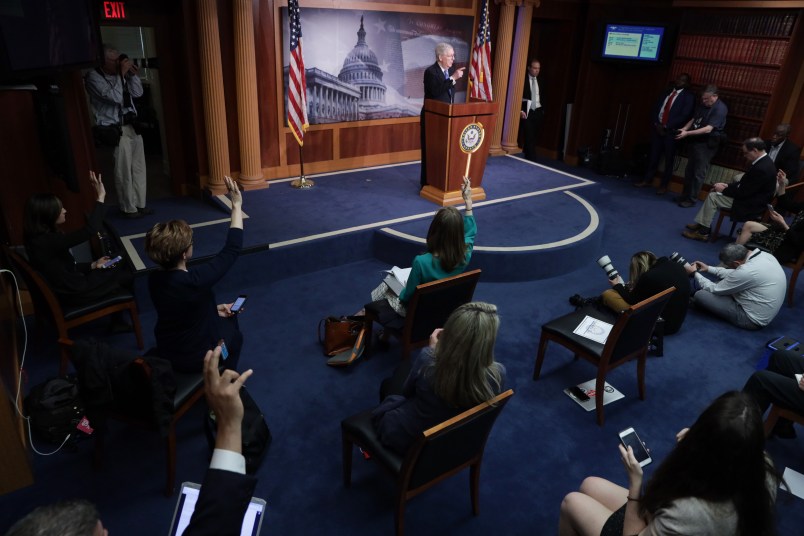Congress is currently enmeshed in debate about whether it can and should switch to working and voting remotely as the coronavirus pandemic sweeps through the country.
Sen. Mitch McConnell (R-KY), who has expressed opposition to remote voting, is instead lengthening vote times so senators can pop in and out without being around a lot of their peers. House Speaker Nancy Pelosi (D-CA) instructed Rep. Jim McGovern (D-MA), chairman of the House Rules Committee, to prepare a report for members on what allowances the rules grant for voting.
The situation has intensified as two members of Congress, Reps. Mario Diaz-Balart (R-FL) and Ben McAdams (D-UT), announced that they have contracted the disease, sending a flurry of other lawmakers into quarantine who’d recently interacted with the two.
“There’s been resistance from McConnell and, to some extent, Pelosi,” Norm Ornstein, resident scholar at the American Enterprise Institute, told TPM. “Part of me fears that McConnell is opposed to this because he’s perfectly okay with a government run by fiat, run by Donald Trump. But assuming that he’s opposing this for good faith reasons, I would’ve thought when two members came down with the virus and a substantial enough number of their peers had to self-quarantine, it’d be enough of a wake up call.”
Though the pandemic is new, Congress has confronted this question before.
Just after the 9/11 terrorist attacks, members of Congress and external experts alike worked on contingency plans in case another, more cataclysmic attack did manage to reach the Capitol or White House.
Ornstein was there, too, part of the Continuity of Government Commission.
“Back then, people thought we had a catastrophe that probably won’t happen again and there was inertia,” he said. “I always expected we would get another bite at apple, and hoped it wouldn’t happen too late.”
One bill, introduced in the wake of the attack by Rep. Jim Langevin (D-RI), addressed the precise problem Congress is grappling with now: a system members could use to debate and vote remotely, from the safety of their homes.
His legislation would have required the National Institute of Standards and Technology to “investigate the feasibility and costs” of setting up a secure computer system for members, and to report back its findings in a year’s time.
“This plan would only be executed in an emergency,” Lengevin said at the time. “The traditional personal, face-to-face interactions that we all enjoy would not be jeopardized. The E-Congress idea is simply a means to facilitate an organized system for congressional continuity if, and only if, an attack or disaster strikes again.”
The bill, like the bulk of the proposals, went nowhere.
Ornstein said that the specter of remote work becoming “too attractive” loomed large in members’ heads then, and that the face-to-face tradition of the Congress was strong driver of lawmakers’ skepticism.
One change that was made to House rules four years after the attacks is the addition of the so-called “catastrophe quorum.”
In extraordinary circumstances, after a quorum call is issued, members have 72 hours to get to the chamber to vote. Then the sergeant-at-arms would then present to the chamber a “catastrophic quorum failure report” to account for the absences. After another 24 hours, the vote proceeds with the much smaller-than-normal body of members.
But even that change was made with terrorist attacks in mind, leaving members now to grapple with the semantics of the paragraphs. How many members have to be quarantined, or sick, or otherwise unable to vote in person to qualify as a “catastrophe”? On top of that, the contingency clause still requires at least some members to show up to vote in person.
And that’s just on the House side; the Senate has never taken up any similar provisional quorum rules. If, say, half the Senate was quarantined and unable to show up to vote, the chamber would grind to a halt.
Still, some House members are trying to force the issue.
Reps. Katie Porter (D-CA), Eric Swalwell (D-CA) and Van Taylor (R-TX) have amassed over 50 signatures on a letter urging Pelosi to allow remote work and voting.
In the other chamber, Sens. Rob Portman (R-OH) and Dick Durbin (D-IL) have introduced a resolution to amend the Senate rules and allow voting from home.
Ornstein said that the Portman-Durbin resolution is on the right track to make remote voting a reality, since it must be triggered by the leaders for a limited duration with the opportunity to renew it. He added that an emergency-based resolution may assuage lawmakers’ concerns that stymied his work some 20 years ago, when he was fighting the resistance to cultural change within the Capitol.
“The conclusion that we came to then and you have to come to now is that we’re not talking about the choice between a different kind of legislature that doesn’t operate the way it’s supposed to and one that does,” he said. “We’re talking about a Congress or no Congress.”



